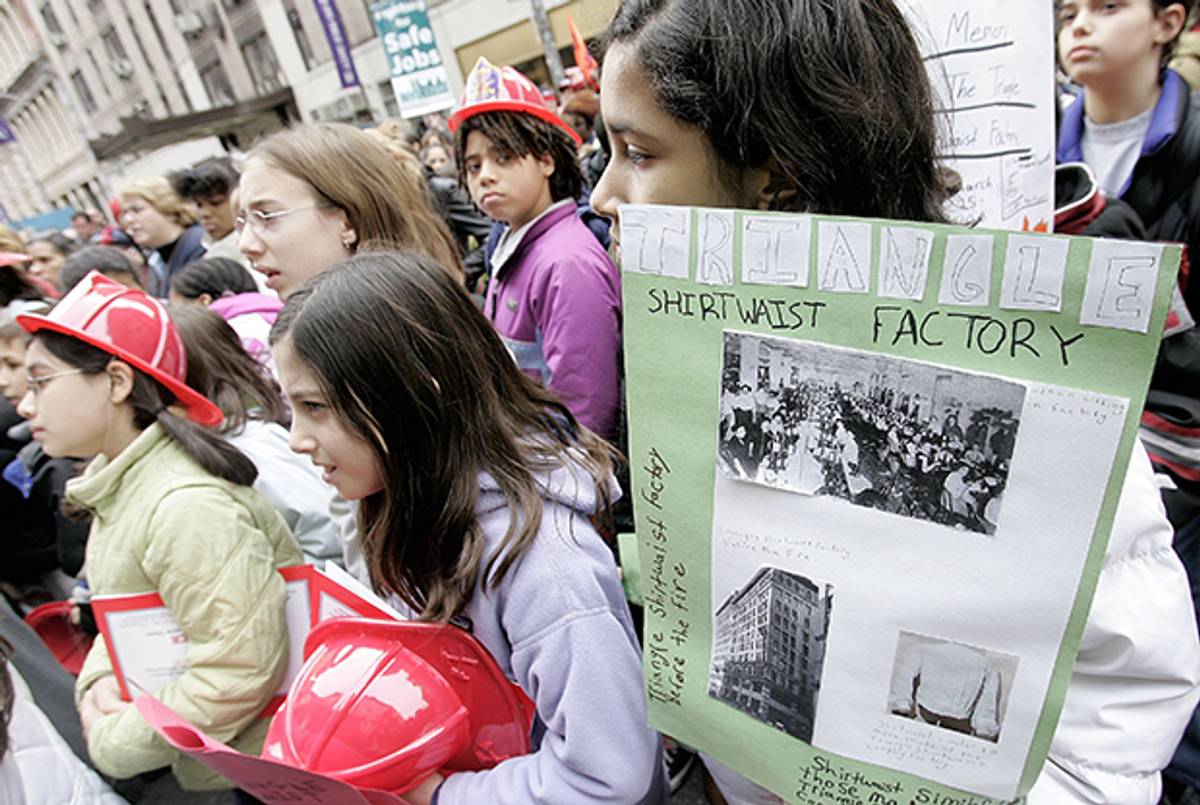
Every year, my daughter Josie and I participate in Chalk, a public art project that takes place on the anniversary of the Triangle Factory Fire. The fire, as you know, catalyzed the workers’ rights, workplace safety, and union movements. To commemorate it, volunteers spread out around New York City every year on its anniversary, writing the names of the the victims—146 of them, mostly young immigrant Jewish and Italian girls—in chalk front of the addresses where they used to live. We write down the age of the victim when she died, the fact that she was killed at the Triangle Factory. If you are Josie and me, you add flowers, curlicues, and hearts.
Some of the tenements where the victims lived are now gone, replaced by fancy boutiques or big high-rises. But because so many of the victims lived in the East Village, where gentrification hasn’t yet completely taken over, many of the homes look much the same—at least on the outside—as they did back in 1911.
Josie and I are each a bit obsessed with the fire. When she was six, she learned about it in a chapter book for beginning readers. (I swear I didn’t give it to her.) Fire at the Triangle Factory is a good introduction for little kids, because it’s as gentle as a story can be about a horrible event without minimizing the horror. It’s a fictionalized account of two girls, one Italian and one Jewish, friends despite their differences, who work at the factory and survive the blaze. I have no idea when my own obsession started…but it was a long time ago. I can’t even remember if it began before or after I met the man who would become my husband, a man who shares a last name—Steuer—with and is distantly related to the lawyer who defended the factory owners (and got them acquitted despite their clear role in their workers’ deaths). Our daughter Maxine often goes by Max, meaning she has the exact same name as her shark-like relative. I swear this was an oversight.
When I wrote for Tablet about the Fire on its 100th anniversary, I think I went too far in my awkward attempt to say that we need to make the Fire an ongoing story about the need for social justice rather than a good vs. evil story about something that happened a long time ago. I was trying to make a broader point about ongoing workers’ rights issues and workplace safety, but at some level I think I wanted to exonerate Jonathan’s cousin, who is remembered as an anti-Semitic cartoon: a short, hawk-nosed, high-priced shyster with hooded eyes who defended evil people. And I felt terrible for Susan Harris, the granddaughter of one of the factory’s owners, a lovely woman I got to know at some Triangle remembrance and Labor Day events. An artist, she embroiders vintage shirtwaists with the names of the victims as a way to grapple with her family’s legacy.
Josie and I have chalked together since she was seven. That first year, she asked Ruth Sergel, the creator of Chalk, if she could chalk for the youngest victim. Ruth gave us Kate Leone, who died at 14, sharing the distinction with Rosaria Maltese of being the baby of the sweatshop’s lost workers. We’ve chalked Kate’s name every year since then. Now Josie is 13. Next year, she will be Kate’s age. And then, God willing, she will keep getting older while Kate stays the same.
Chalking is intertwined with our lives in our neighborhood. Ruth used to live across the street from us. Michael Hirsch, the independent researcher who uncovered the names of the last six unidentified victims, lives nearby. I met the now-elderly nephews of Rosaria Maltese at a screening of a documentary about the fire; as kids, they attended Josie and Maxie’s school, and in high school, one of them dated a girl who lived on the same floor of our apartment building. We get birthday cakes at Veniero’s, the wonderful old Italian bakery in the neighborhood above which 16-year-old Jenne Franco, one of the victims, lived. Kate lived several blocks further east on the same street. Victims lived all around us—one block east of our apartment, one block west, two around the corner. The factory itself, now an NYU science building, is a few blocks away. There is a pink marble memorial in Tompkins Square Park, where my kids grew up playing.
It’s not enough, of course, to remember this seminal event as part of our personal history, or even as New York City history, Jewish history, or labor history. It’s not just history. Clothing companies a lot of us buy from have been caught using overseas sweatshop labor—Nike, H&M, The Gap, Victoria’s Secret. Many of us have worried about the conditions that produced our beloved Apple products. Some companies have improved their labor practices; others haven’t. In 2012, a fire swept through a Bangladeshi factory making clothes for Walmart and Sears, killing 112 workers.
Like chalk marks on sidewalks, the lessons we learn about paying a fair price for work seem to fade away as often as they’re written down.
Related: Lost in the Fire
Marjorie Ingall is a former columnist for Tablet, the author of Mamaleh Knows Best, and a frequent contributor to the New York Times Book Review.